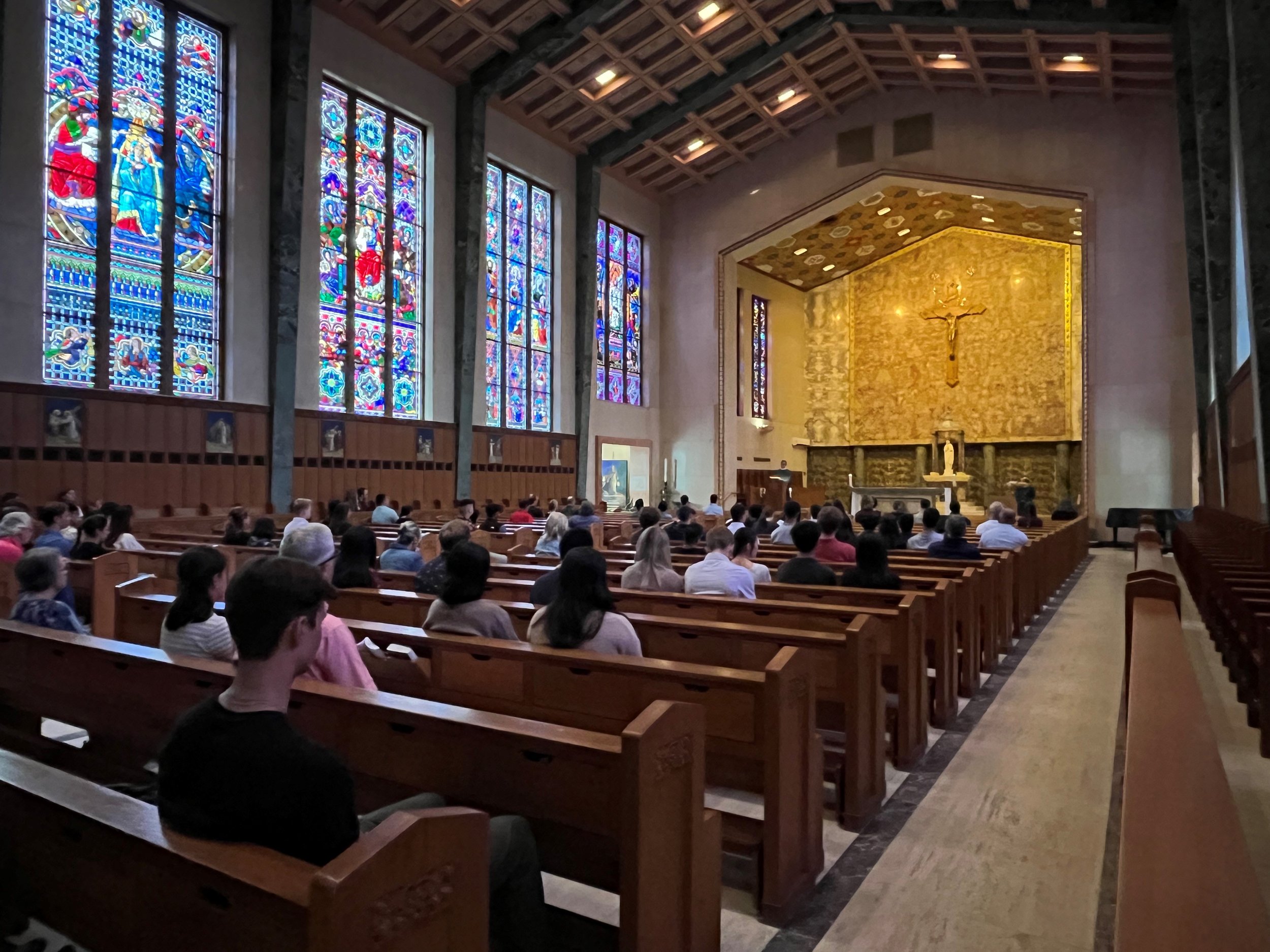Joy is the kind of happiness that does not depend on what happens.
David Steindl-Rast
Blog
It was late Sunday afternoon when I learned that King’s University Parish offered a 5:00 pm Mass for its students. Pressed for time, I quickly drove to the main campus and hurried into the small chapel. There in silence sat only a young couple expecting to attend Mass. No candles were lit, no presider was present. Soon, the young man consulted his phone and announced that Mass was at the nearby spacious King’s College Chapel – formerly our community’s Mount St. Joseph chapel.
As I sped down Huron Street, I wondered why a five-o’clock Sunday Mass would be held in such a large space for a few students. Several minutes later I parked the car, raced up the wide cement steps and entered the foyer. Now, out of breath, I hurried across the marble floor and gingerly opened the chapel door. I stopped in my tracks as I beheld the pews filled with young students raising their voices and praising God to the organ strains of a timely Lenten hymn.

I couldn’t believe my eyes and ears! A sense of quiet awe permeated the atmosphere as young men and women of many colors and races worshiped in faith and solidarity as their chaplain, assisted by the college deacon, led the beautiful celebration of the Eucharist. I felt a solemnity and beauty that transcended the ordinary.
Voices in my head reminded me of what I often thought and what many others believe: “Young people don’t go to church anymore”. “Few practice their faith these days”. “What is our world coming to”?

Wait a minute, I thought, how could we have been so wrong? Here I was among a devout crowd in line to receive communion singing the haunting words, “Eat this bread, drink this cup, come to me and never be hungry”. Here they received sustenance and strength at a weekly Sunday Service.
Following the ceremony, the feeling of fellowship that had begun at Mass continued as a large group made their way downstairs to an inviting room where coffee, crusty buns, and four kinds of soup were served from hot urns by student volunteers. Sitting around white tables, fellowship and friendly chatter filled the room. It was all so simple, heartfelt, and real.
Even as the academic year draws to a close and students head out of town, a considerable number will continue to attend Sunday Service. Come September, the chapel will be filled again with devout students. Now I know that faith is alive and active in students at King’s University College, and in many other places as well.
-Sister Jean Moylan, csj
As time passes, more and more of our Canadian story is coming to light. A significant part of our nation’s story encompasses the unique yet not so uncommon stories of individuals. The historical account of British Home Children is one such little known part of Canada’s history.

You may ask, “Who are the British Home Children?” The Government of Canada’s website answers the preceding question in the following manner. “Between 1869 and 1939, over 100,000 children were sent from Britain to Canada through assisted juvenile emigration. These migrants are called “home children” because most went from an emigration agency's home for children in Britain to its Canadian receiving home. The children were mostly placed with families in rural Canada.”
Children of all ages, both boys and girls were sent across Canada from England to spend their early life respectively as farm workers and domestics. Although Canadians believed them to be orphans only two percent actually were parentless. Because there was no social system to help parents or sole parents who had fallen on hard times through difficult circumstances these youngsters were often surrendered into the care of organizations. Dr. Barnardo’s Homes was one of the largest of these organization.

Inspired by true events, The Forgotten Home Child is a moving and heartbreaking novel about place, belonging, and family—the one we make for ourselves and its enduring power to draw us home.
Some of these children were blessed to ended up in loving families. Unfortunately, this was often not the fate they experienced.
I learned more about this aspect of Canadian history and the experiences of these children through reading The Forgotten Home Child by Genevieve Graham. An inspired story based on a composite of true events touching the heart and highlighting the phenomenon of finding one’s family identity beyond blood ties.
An enlightening read that I would very much recommend.
- Sister Nancy Wales, CSJ
As we savour the mystery and blessings of Jesus’ Resurrection may we turn our thoughts and attention to the words of Isaiah to discover the manner in which we as Easter People are called and challenged to live out the message of this good news.

Enlarge the site of your tent,
and let the curtains of your habitations be stretched out;
do not hold back; lengthen your cords
and strengthen your stakes. Isaiah 54:2
More than ever in our current times we are challenged to enlarge our tent, symbolically to extend hospitality and refuge to one another.
Ironically, Robert Ingersoll, although nicknamed “the Great Agnostic” reminds us , as I presume Jesus, the Risen One would that we rise by lifting others up. In what ways are we being called to lift the spirits of one another?
This generosity of spirit is set as an example for us by Jesus as he washed the feet of his disciples at the Last Supper. He calls upon us to wash one another’s feet. (John 13:1-17)
As renewed Easter People let us be welcoming tent dwellers and warm-hearted foot washers for those we encounter.
-Sister Nancy Wales, CSJ
